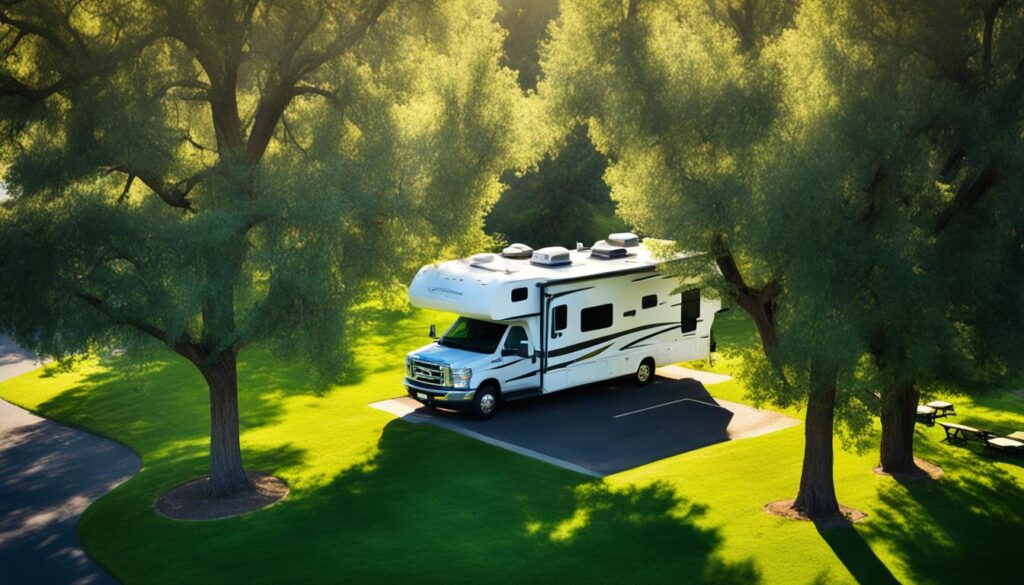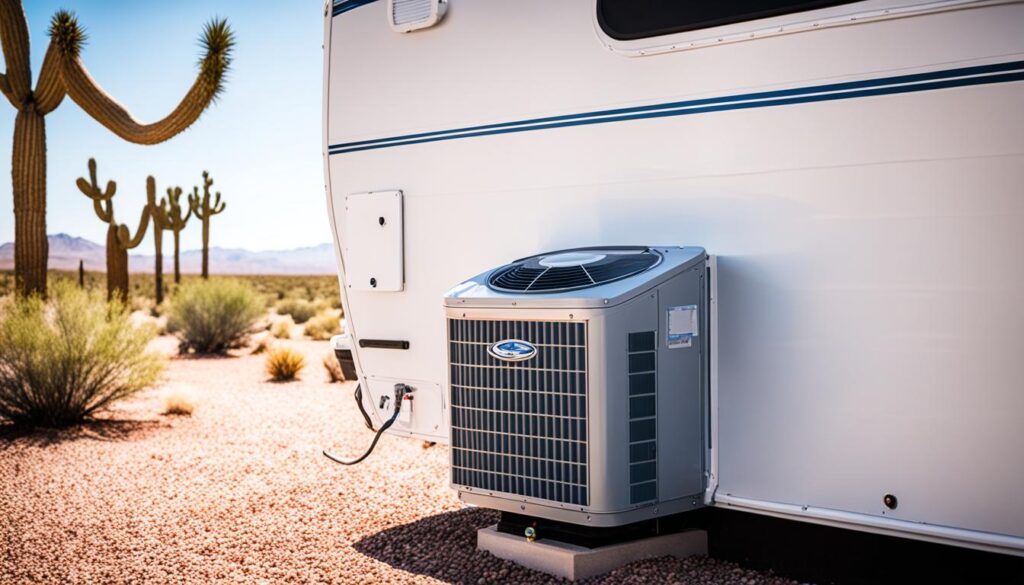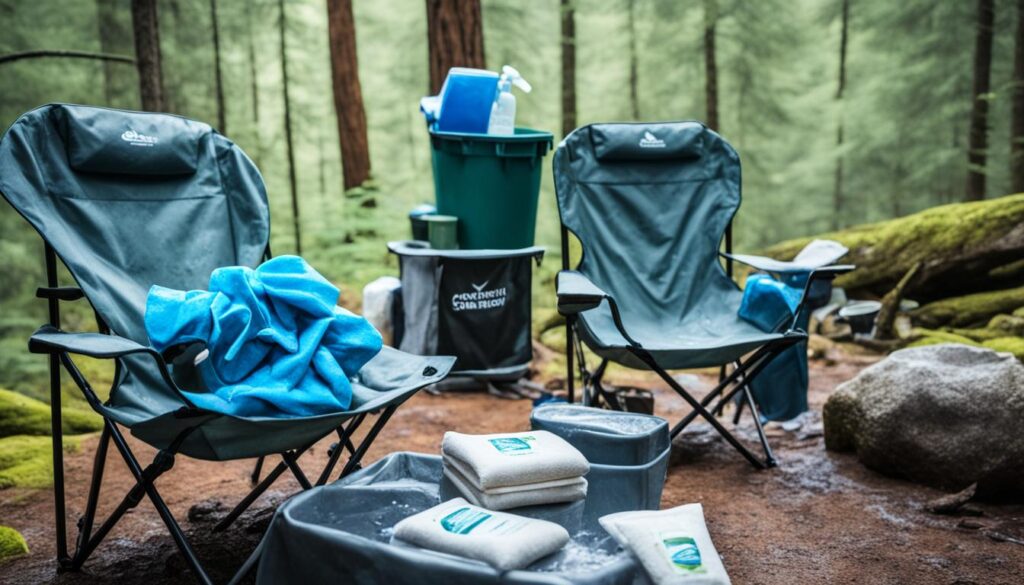Are you tired of sweltering summer days in your RV, desperately searching for ways to make your air conditioner colder? Look no further! In this article, I will share with you some valuable tips and tricks to enhance your RV air conditioner’s cooling performance and maximize its efficiency. Whether you’re camping in the scorching heat or navigating through humid destinations, these strategies will ensure you stay cool and comfortable throughout your journey.
Key Takeaways:
- By troubleshooting common issues, you can identify and address any problems that may hinder your RV air conditioner’s cooling capability.
- Parking your RV in the shade can significantly improve the cooling efficiency of your air conditioner by reducing direct sunlight exposure.
- Insulating windows and roof vents helps prevent heat gain and ensures a cooler interior temperature in your RV.
- Cleaning or replacing the inside air filter(s) improves airflow, leading to enhanced cooling performance.
- Regularly cleaning the coils and fins of your RV air conditioner is crucial to maintain optimal airflow and improve cooling efficiency.
- Ensure your RV has sufficient power to run the air conditioner effectively by checking the power supply and maintaining the generator.
- If you don’t have access to an RV air conditioner or want to reduce reliance on it, alternative methods such as parking in shade, opening windows, and using fans can help you stay cool.
Contents
- 1 Troubleshooting Your RV AC Not Cooling
- 2 Park Your RV in the Shade for Improved Cooling
- 3 Insulate Windows and Roof Vents for Better Cooling
- 4 Clean or Replace the Inside Air Filter(s) for Enhanced Cooling
- 5 Clean the Coils or Fins for Improved AC Performance
- 6 Ensure Sufficient Power to Maximize Cooling
- 7 Additional Tips for Cooling Your RV Without an AC
- 8 FAQ
- 9 Source Links
Troubleshooting Your RV AC Not Cooling
If your RV AC isn’t cooling as it should, troubleshooting is necessary. Understanding the diagram of an RV rooftop air conditioning unit can provide valuable insights for identifying and addressing the issue with a DIY solution. Here are some common troubleshooting steps to help you get started:
- Check the power source: Ensure that your RV is receiving sufficient power for the AC unit to function properly. Check the circuit breaker and make sure it is not tripped.
- Ensure proper ventilation: Ensure that the RV AC unit has adequate space around it for proper airflow. Remove any obstructions that may be blocking the vents or intake/exhaust areas.
- Inspect for blockages or obstructions: Check for any debris, leaves, or other materials that may be obstructing the airflow in the AC unit. Clear any blockages that you find.
By following these troubleshooting steps, you can often diagnose and resolve issues with your RV AC not cooling efficiently. However, if the problem persists or if you are unsure about performing the troubleshooting yourself, it is recommended to consult a professional RV technician for further assistance.
“Proper troubleshooting can help identify and resolve the underlying issues affecting the cooling performance of your RV AC unit.” – RV Expert
| Issue | Possible Cause | Solution |
|---|---|---|
| RV AC not turning on | Faulty thermostat, power supply issues | Check thermostat settings, inspect power connections |
| Poor cooling performance | Clogged air filter, dirty coils or fins | Clean or replace air filter, clean coils and fins |
| Inconsistent cooling | Refrigerant leaks, faulty compressor | Consult a professional technician for repair |
Remember, proper maintenance and regular inspections can help prevent many RV AC issues from occurring. Performing routine checks and troubleshooting can save you time and money in the long run, ensuring optimal cooling performance for your RV.
Park Your RV in the Shade for Improved Cooling
If you want to enhance the cooling efficiency of your RV air conditioner, one simple tip is to park your RV in the shade. By reducing the exposure to direct sunlight, you can minimize the heat absorbed by the RV and, in turn, lower the workload of the AC unit. This can make a noticeable difference in the cooling performance of your RV AC, allowing you to enjoy a more comfortable experience even on hot summer days.
Parking in the shade not only helps keep the interior temperature of your RV cooler but also reduces the strain on the AC compressor. When your RV is exposed to direct sunlight, the heat can quickly build up inside, making it harder for the AC unit to effectively cool the space. By parking in the shade, you create a cooler environment for your RV, making it easier for the AC unit to maintain a comfortable temperature.
Additionally, parking in the shade helps minimize the amount of direct sunlight that penetrates through the RV windows. Sunlight can contribute to the greenhouse effect, trapping heat inside and making it more challenging for the AC unit to cool the interior. By reducing the sunlight exposure, you allow the AC unit to work more efficiently and effectively.

When choosing a parking spot for your RV, look for shaded areas such as under trees or near buildings that provide adequate shade. Keep in mind that the shade patterns may vary throughout the day, so you may need to adjust your parking position accordingly. Additionally, using awnings or RV sunshades can also help block out direct sunlight and provide additional shade for your RV.
Overall, by simply parking your RV in the shade, you can significantly improve the cooling efficiency of your RV AC. This, in turn, allows you to maximize your comfort while minimizing the strain on your AC unit. Remember to take advantage of shaded areas whenever possible to optimize your RV’s cooling performance.
Insulate Windows and Roof Vents for Better Cooling
When it comes to improving the cooling efficiency of your RV, insulating windows and roof vents is a crucial step. By preventing the sun’s heat from entering your RV and raising the interior temperature, you can create a more comfortable environment inside. A popular product for insulating windows is Reflectix, a bubble wrap with a reflective film that helps to reflect heat away from your RV.
Additionally, you can also explore DIY solutions or purchase insulators specifically designed for roof vents. These insulators help to maintain the desired temperature inside your RV by reducing heat gain from the outside. By insulating your RV windows and roof vents, you can significantly improve the cooling effectiveness of your RV AC, maximizing your comfort while on the road.
Insulating Windows and Roof Vents: Benefits at a Glance
| Benefits | Explanation |
|---|---|
| Reduced heat transfer | Insulation acts as a barrier, preventing heat from entering your RV through windows and roof vents. |
| Improved energy efficiency | Insulation helps to keep the cool air inside and reduce the workload on your RV AC, leading to better energy efficiency. |
| Enhanced comfort | Insulating windows and roof vents can create a more comfortable interior environment by reducing temperature fluctuations. |
| Noise reduction | Insulation materials can also help to minimize outside noise, providing a quieter and more peaceful atmosphere inside your RV. |
Investing in insulation for your windows and roof vents is a worthwhile step to improve your RV AC cooling performance. By reducing heat gain and maintaining a comfortable interior temperature, you can enhance your overall travel experience and enjoy a cooler environment even on the hottest days.
Clean or Replace the Inside Air Filter(s) for Enhanced Cooling
Dirty or clogged air filters can significantly impact the performance of your RV air conditioner. When the filters are not clean, they restrict airflow, resulting in reduced cooling capacity. To ensure optimal cooling, it is important to regularly clean or replace the air filters in your RV AC system.
The process of cleaning or replacing the air filters may differ depending on the type of filter used in your RV AC unit. Refer to the manufacturer’s instructions or the user manual for specific guidance. Generally, cleaning reusable filters involves removing the filter from its housing and gently rinsing it with water. Let it dry completely before reinstalling. For disposable filters, simply remove the old filter and replace it with a new one.
Proper maintenance of the air filters is essential for unrestricted airflow and improved cooling performance. By keeping the filters clean or replacing them when necessary, you can enhance the overall airflow in your RV AC system and achieve better cooling throughout your vehicle.
Dirty or clogged air filters can restrict airflow and reduce the cooling capacity of your RV AC.
Recommended Steps to Clean or Replace RV Air Filters:
- Refer to the manufacturer’s instructions or the user manual for your RV AC unit.
- If using reusable filters, remove the filter from its housing.
- Gently rinse the filter with water to remove dirt and debris.
- Allow the filter to dry completely before reinstalling.
- If using disposable filters, remove the old filter.
- Install a new filter in its place, following the manufacturer’s recommendations.
Regularly inspecting and maintaining your RV air filters will ensure optimal airflow and improve the cooling efficiency of your RV AC system. By following the recommended cleaning or replacement steps, you can maximize the performance of your RV’s cooling system and enjoy a comfortable environment during your travels.

Clean the Coils or Fins for Improved AC Performance
The coils and fins of your RV AC are vital components that greatly impact its cooling performance. Over time, these parts can collect dirt and debris, leading to decreased efficiency in the AC unit. To ensure optimal airflow and enhance cooling performance, it is crucial to regularly clean the coils and fins. Follow the recommended steps below to keep your RV AC running at its best:
Cleaning RV AC Coils
1. Turn off the RV AC and disconnect the power source.
2. Remove any protective covers or grilles to access the coils.
3. Use a soft brush or vacuum cleaner with a brush attachment to gently remove dirt and debris from the coils.
4. If there are stubborn residues, you can use a specialized coil cleaner following the manufacturer’s instructions.
5. Once the coils are cleaned, ensure they are completely dry before reassembling any covers or grilles.
Cleaning RV AC Fins
1. Turn off the RV AC and disconnect the power source.
2. Locate the fins on the exterior of the AC unit.
3. Gently brush the fins with a soft brush, following the direction of the fins to avoid bending them.
4. For more thorough cleaning, use a fin comb to straighten any bent fins and remove debris lodged between them.
5. After cleaning, reassemble any removed parts and ensure proper reattachment.
By regularly cleaning the coils and fins of your RV AC, you can maintain optimal airflow and improve the overall efficiency of the unit. This will result in enhanced cooling performance and a more comfortable RV experience, particularly in hot weather conditions.
| Task | Frequency |
|---|---|
| Cleaning RV AC Coils | Every 3 months |
| Cleaning RV AC Fins | Every 1 month |
Pro Tip: Regularly inspect and clean your RV AC coils and fins during routine maintenance. This will not only improve cooling performance but also extend the lifespan of your AC unit.
Ensure Sufficient Power to Maximize Cooling
Ensuring that your RV AC has sufficient power is essential for optimizing cooling performance. Whether you rely on a generator or have a 30 or 50 amp electrical supply, it’s important to meet the power requirements of your RV AC unit.
If you are using a generator, make sure it can provide enough power to run the AC unit smoothly. Check the output capacity of your generator and ensure it meets or exceeds the power consumption of your RV AC.
For RVs plugged into 30 or 50 amp outlets, ensure that the electrical supply is adequate to handle the AC unit’s power demands. If you’re unsure about the electrical capacity, consult a professional electrician or refer to the manufacturer’s specifications for your RV and AC unit.
Insufficient power can negatively impact the cooling capacity of your RV AC, leading to suboptimal performance and discomfort during hot weather. By addressing any power-related issues and ensuring a reliable power supply, you can optimize the cooling capabilities of your RV AC for a comfortable and enjoyable camping experience.
Common Power-Related Issues to Check:
- Verify that your generator or electrical supply is capable of delivering the required power for your RV AC unit.
- Inspect the power cords and connections for any damage or loose connections.
- Ensure that the circuit breaker or fuse for the AC unit is in proper working condition.
- Consider using a surge protector to protect your AC unit from potential electrical surges.
Additional Tips to Optimize RV AC Cooling:
- Close windows and doors to minimize heat transfer between the interior and exterior of the RV.
- Use window coverings or reflective shades to reduce heat gain from sunlight.
- Keep the AC vents unobstructed for efficient airflow.
- Consider using fan accessories or supplementary cooling methods to complement your RV AC unit.
Additional Tips for Cooling Your RV Without an AC
If you find yourself without access to an RV AC or want to reduce your reliance on it, there are alternative methods to stay cool and comfortable. Follow these tips to beat the heat and enjoy your RVing experience:
Park in the shade: Choosing a shady spot to park your RV can significantly lower the interior temperature. By reducing direct sunlight exposure, you can create a cooler environment without relying solely on your AC.
Open windows for natural airflow: Allowing fresh air to circulate inside your RV can provide natural cooling. Be mindful of bugs and insects, and consider installing bug screens to keep unwanted guests at bay.
Utilize battery-powered fans: Battery-powered fans are a great way to enhance airflow inside your RV. Place them strategically to create a cooling breeze and improve overall comfort.
Avoid using heat-generating appliances: Appliances such as ovens, stoves, and even certain types of lighting can generate heat and raise the temperature inside your RV. Opt for cooler alternatives or use them sparingly during the hottest times of the day.
Utilize awnings or shade features: If your RV has awnings or shade features, make use of them to create a cooler outdoor space. Enjoy the shade and avoid direct exposure to the sun, especially during peak heat hours.
By implementing these alternative cooling methods, you can stay cool without an RV AC and make the most of your RVing adventures, even in hot weather conditions.
FAQ
How do I make my RV air conditioner colder?
To make your RV air conditioner colder, you can try troubleshooting the unit, parking your RV in the shade, insulating windows and roof vents, cleaning or replacing the air filter(s), cleaning the coils or fins, and ensuring sufficient power supply for optimal cooling.
How can I improve my RV air conditioner performance?
To improve your RV air conditioner performance, you can troubleshoot any issues, park your RV in the shade, insulate windows and roof vents, clean or replace the air filter(s), clean the coils or fins, and ensure sufficient power supply to the unit.
How can I enhance the cooling of my RV air conditioner?
You can enhance the cooling of your RV air conditioner by troubleshooting the unit, parking your RV in the shade, insulating windows and roof vents, cleaning or replacing the air filter(s), cleaning the coils or fins, and ensuring sufficient power supply for optimal cooling.
How do I maximize the efficiency of my RV air conditioner?
To maximize the efficiency of your RV air conditioner, you can troubleshoot any issues, park your RV in the shade, insulate windows and roof vents, clean or replace the air filter(s), clean the coils or fins, and ensure sufficient power supply for optimal cooling.
How can I make my RV air conditioner colder?
To make your RV air conditioner colder, you can troubleshoot any issues, park your RV in the shade, insulate windows and roof vents, clean or replace the air filter(s), clean the coils or fins, and ensure sufficient power supply for optimal cooling.
What should I do if my RV air conditioner is not cooling?
If your RV air conditioner is not cooling, you can try troubleshooting the unit by checking the power source, ensuring proper ventilation, and inspecting for any blockages or obstructions. You can also refer to the diagram of an RV rooftop air conditioning unit for a better understanding of the components.
How does parking my RV in the shade improve cooling?
Parking your RV in the shade can improve cooling by reducing the exposure to direct sunlight, which minimizes the heat absorbed by the RV and lowers the workload of the air conditioner. This simple tip can make a noticeable difference in the cooling performance of your RV air conditioner.
How can I insulate my RV windows and roof vents for better cooling?
You can insulate your RV windows by using products like Reflectix, a bubble wrap with a reflective film, or by using DIY solutions or purchasing insulators specifically designed for windows. For roof vents, you can use insulators specifically designed for them. Insulating windows and roof vents helps prevent the sun’s heat from entering your RV and raising the interior temperature, thus improving the cooling efficiency of your RV air conditioner.
How often should I clean or replace the air filter(s) in my RV air conditioner?
Cleaning or replacing the air filter(s) of your RV air conditioner depends on the type of filter. It is recommended to check the manufacturer’s instructions for specific guidelines. In general, it’s good practice to clean or replace the filters regularly to ensure unrestricted airflow, which improves cooling performance.
How do I clean the coils or fins of my RV air conditioner?
To clean the coils or fins of your RV air conditioner, follow the recommended steps provided by the manufacturer. This typically involves removing any debris, dirt, or dust using a soft brush or vacuum cleaner. Regularly cleaning these components will help maintain proper airflow and improve cooling performance.
What should I check to ensure sufficient power for my RV air conditioner?
To ensure sufficient power for your RV air conditioner, check if your generator can provide enough power to run the AC unit. For RVs plugged into 30 or 50 amp outlets, ensure the electrical supply is adequate. Insufficient power can negatively impact the cooling capacity of your RV air conditioner, so it’s important to check and address any power-related issues.
Are there alternative methods to cool my RV without using the air conditioner?
Yes, there are alternative methods to cool your RV without using the air conditioner. You can park in the shade to reduce the heat, open windows to let in fresh air, park near a water source for natural cooling, use battery-powered fans, avoid using heat-generating appliances, and utilize awnings or shade features. These tips can help you stay comfortable even without an RV air conditioner.






